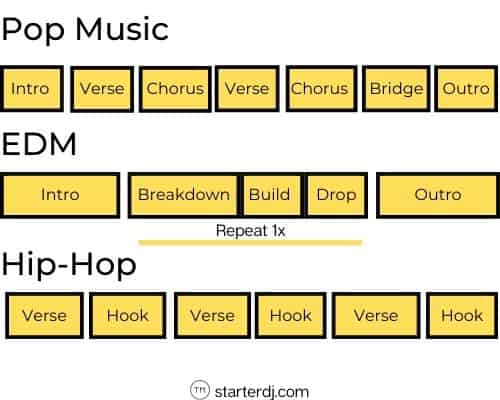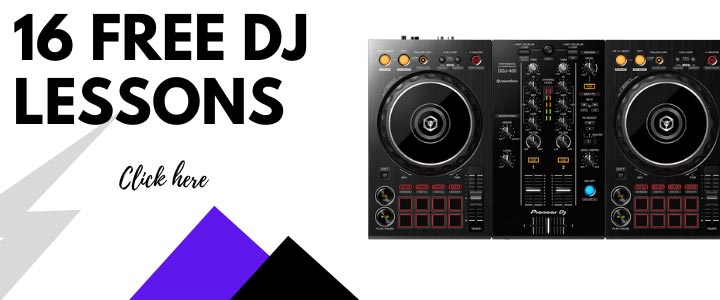When to Mix in a New Song? An Explanation for Beginner DJs
When to mix in a new song is a foundational skill that every DJ has to master. It’s a skill that I’ve always practised a lot and I still do. Today I’ll share with you everything that you need to know about when to mix in a new song, so you can start practising it too.
The right moment to mix in a new song is at the end of a phrase. Like the end the chorus or the start of the outro. These are the most commonly used points to mix in a new song. This is called phrase mixing.
Phrase mixing is simply honouring the structure of songs. You don’t stop playing a song halfway through the most popular part. You wait until the chorus is done, before fully cutting it off.
Songs have structures for a reason. The producers of the songs know that these popular structures are what keeps the people hooked to the song. So don’t mess with it.
You should be aware though, especially if you’re an open format DJ, is that not all songs are created equal. That’s why, to really learn how to mix in a new song on all song structures, there are a few things to learn. Continue reading if you want to know more.
What You Need to Learn Before You Start Mixing Songs
Before you can make smooth transitions and awesome beat drops, you have to learn how to count music.
Counting music takes some practice, but when you know how to do it, you’ll find yourself doing it out of habit.
There are some great resources on youtube that will teach you how to count music. Below you will find my favorite YouTube video on this topic. The one where I have learned how to do it. It’s a great video by DJ TLM.
The Best Places to Mix in a New Song
To know the best place to start to mix in a new song, we have to look at the song structure.
The image below shows the most common music structures of 3 different types of genres. As you can see; pop, EDM, and hip-hop tracks often have very different structures.

The above image only shows 3 music genres but when you have knowledge about what a verse, a chorus or a hook sound like, you will be able to recognise it in all genres.
I recommend listening to a couple of songs and try to recognise the different parts of a song.
Like I mentioned before; Mixing with song structure in mind is a part of phrase mixing, You can check out my article on phrase mixing if you want to know more about it.
Depending on the music structure, generally the best points to mix in are:
- After the first or second chorus
- At the beginning of the outro
- During the breakdown
Some genres are easier to mix than other genres. Mixing pop songs, for example, can be tough because these songs have a lot of vocals and not a lot of instrumental parts. When they do have instrumental parts they’re often not long enough to smoothly mix in a new song.
When you want to mix pop songs I highly recommend you download your songs from a DJ Pool. In a DJ Pool, you can download versions of the songs that include intros and outros. (Check out my guide to DJ pools if you want to know more)
Another way to mix in a new song is by dropping your new song in on the one count, without actually mixing. So you go from one song to the other one. (Further down in this article you’ll find more information on how to do this).

Dropping the new song in on the one will be most effective right after the first or second chorus. When you want to start your new song with the chorus, though, it would be better to drop it in after a verse or a bridge. This way you won’t get a chorus 2 times in a row.
EDM and house tracks are probably easiest to mix in a new song because they often don’t have vocals or not enough of them to make it hard to mix. They also have longer phrases, so you have more time to mix. This is why EDM and house tracks are also great for practicing your mixing skills.
When Not to Mix in a New Song?
When you are looking for a point to mix in the next song, there are also some signals that you really shouldn’t start mixing. It’s not just about the timing but also about basic mixing rules.
Here are 2 rules on what not to do:
- Don’t mix vocals over vocals, unless you really know what you’re doing.
Vocals over vocals can be amazing if done right. I don’t recommend you to try this when you’re a beginner though. The difficulty level is very high and if it goes wrong, it goes horribly wrong. It’s just not worth the trauma.
- Never mix in before the drop (unless you’re drop swapping)
You know that moment when the music builds and builds. Your body is slowly filling with energy and you can feel the moment is almost there. That exciting anticipation during the build-up before that groundbreaking drop.
Now imagine, you’re filled to the top with energy and you can feel that moment of the drop coming in. Then suddenly the DJ switches to another song, and the energy level changes in a split second.
It’s that moment that for a couple of seconds you see people on the dancefloor looking and acting kind of awkward and weird. It’s what happens when you mix in a new song before the drop.
There is 1 really cool exception to this rule. Switching the drop of that song with the drop of another song. This way the energy remains high and there is a nice surprise factor.
Make sure you know how to do it before you start mixing songs.
3 Examples of When and How to Mix in a New Song
Example 1: Outro of song 1 – Mix in the intro of song 2
- Song 1 is playing through your speakers.
- Load song 2 and set the starting point at the intro.
- Song 1 is almost ready to reach the outro
- Start the intro of the next song on your headphones
- Match the beats of both songs
- slowly mix in the second song by slowly turning the volume up
Example 2: Second breakdown of song 1 – mix in intro of song 2
- Song 1 is playing through your speakers
- Song 2 is reaching the second build-up and the second drop
- Start the intro of song 2 with volume down, on the first count of the breakdown of song 1
- Slowly increase the volume of song 2 and decrease the volume of song 1
- Make sure the volume of song 1 is fully decreased when the second song reaches the breakdown
Example 3: End of the second chorus of song 1 – Dropping in the 1st verse of song 2
- Song 1 is playing through your speakers
- Load song 2 at the start of the first verse
- When song 1 reaches the second chorus get ready to make the drop
- at the end of the second chorus of song 1, on the first count of the next phrase, simultaneously turn down song 1 and start the first verse of song 2 (with full volume up)
Extra tip: when you fully want to shut one song down and start the other on the one count (like example number 3); use the crossfader to quickly shut song 1 down and start song 2.
Conclusion: the best point in a song to start mixing in a new song is different for every genre. Look at the song structure to find the best points and stick to the basic mixing rules. When you don’t know how to count, learn to do that first.

